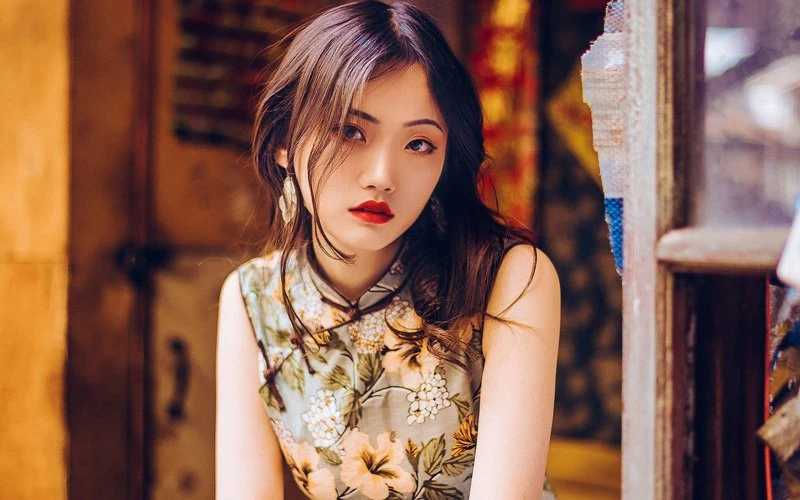CHEONGSAM
Updated 05-May-2020.
Mondo shtuff from around the internet, all about CHEONGSAM!
/thoughtCo_pin_img_default-58a21e1638e9b32984d5b865.png) What Is a Qipao in Chinese Fashion?: Qipao, or cheongsam in Cantonese, is a one-piece Chinese dress that has been worn since the Manchu ruled China in the 17th century.
What Is a Qipao in Chinese Fashion?: Qipao, or cheongsam in Cantonese, is a one-piece Chinese dress that has been worn since the Manchu ruled China in the 17th century.
 What is a Modern Cheongsam? – Chinese Qipao Dress in 2020: The word Qipao originally meant “Qing People’s Robe.” But in modern day, cheongsam dress immediately conjures up images of the famous traditional Chinese outfit, an icon of Eastern Asian fashion and a symbol of Shanghai City, with an enduring appeal the world over. You may think, “Chinese women wear qipao every day or anybody know […]
What is a Modern Cheongsam? – Chinese Qipao Dress in 2020: The word Qipao originally meant “Qing People’s Robe.” But in modern day, cheongsam dress immediately conjures up images of the famous traditional Chinese outfit, an icon of Eastern Asian fashion and a symbol of Shanghai City, with an enduring appeal the world over. You may think, “Chinese women wear qipao every day or anybody know […]
 Cheongsam Wedding Dress: A Style Guide for the Modern Bride: The cheongsam (or qipao) originated nearly a century ago in Shanghai as a modern take on the Manchu dress, and remains one of the most iconic pieces of Chinese fashion. If you’re getting married and looking to honor your own or fiancé’s Chinese heritage, then a cheongsam wedding dress can be the perfect addition to your special day.
Cheongsam Wedding Dress: A Style Guide for the Modern Bride: The cheongsam (or qipao) originated nearly a century ago in Shanghai as a modern take on the Manchu dress, and remains one of the most iconic pieces of Chinese fashion. If you’re getting married and looking to honor your own or fiancé’s Chinese heritage, then a cheongsam wedding dress can be the perfect addition to your special day.
Here’s what the modern bride needs to know about wearing a cheongsam on your wedding day and how to choose one that will have all eyes on you as you walk down the aisle:
What’s the difference between qipao and cheongsam?
Before we dive into the different cheongsam wedding styles, it’s helpful to clarify the difference between cheongsam from the qipao. The term “cheongsam” originated in the south while
 A Brief History Of The Cheongsam: The cheongsam is a timeless and elegant dress. Read all about the origins of this iconic Chinese women’s garment.
A Brief History Of The Cheongsam: The cheongsam is a timeless and elegant dress. Read all about the origins of this iconic Chinese women’s garment.
 Qipao | dress: Other articles where Qipao is discussed: dress: China: This was the qipao, better known in the West by its Cantonese name, cheongsam, or as a “mandarin dress.” The qipao had developed from the changfu. A close-fitting dress made from one piece of material, the qipao was fastened up the right (or more rarely, the left) front…
Qipao | dress: Other articles where Qipao is discussed: dress: China: This was the qipao, better known in the West by its Cantonese name, cheongsam, or as a “mandarin dress.” The qipao had developed from the changfu. A close-fitting dress made from one piece of material, the qipao was fastened up the right (or more rarely, the left) front…
My botty best at summarizing from Wikipedia: the cheongsam is a feminine body-hugging dress with distinctive Chinese features of Manchu origin . it was called mandarin gown during 1920s-1930s, popularised by Chinese socialites and upper- the word qipao (keipo) became a more formal term for the female chèuhngsam . use of the term cheongsam in western countries mostly followed the all Han Chinese were forced under penalty of death to dress in Manchu changpao . order for ordinary non-Banner Han civilians to wear Manchu clothing lifted . some Han civilian men voluntarily adopted Until 1911, the Manchu changpao was required clothing for Chinese men of a certain class . Throughout the Qing dynasty, Han civilian women continued to wear traditional Han clothing from the M the baggy clothing covered most of the wearer’s body, revealing only the head, hands, and tips of the toes . the version seen as the typical qipao in china today was popularized high-class courtesans and celebrities in the city made these redesigned tight fitting qipao popular at that time . in Shanghainese, it was first known as zansae for ‘ in 1930s, many people replaced trousers with stockings . high-heeled shoes became an essential part of qipao fashion set . by the 1940s, trousers had completely fallen out of use . as trend of hosiery declined in later decades, women started to wear qipao more commonly with bare legs . as western fashions evolved, so does the cheongsam design . by the the Shanghainese cheongsam has remained popular in Mainland china . the style functions now mostly as a stylish party dress . many scholars relate its prevalence to the women’s liberation movements . after the Xinhai Revolution of 1911, young Chinese people began to learn western science . the idea of gender equality quickly gained its followers . wearing Cheongsam carried the symbol of promoting gender equality and saving the country the color of Cheongsam was usually cold and rigid . it symbolized a silent protest, as part of the May Fourth Movement and the New Cultural Movement . more and more female workers and celebrities put on . the length of Cheongsam was also reduced from ankle reaching to above the knee . the priority of the design moved from a political expression to ornamental emphasis . cheongsam of the early 1920s had loose cutting, with long, wide sleeves . it became a fashion trend . in the 1930s, the fashion prevailed in Shanghai . in 1940s, the Cheongsam was worn with stockings, and trousers had completely fallen out of use . high-heeled shoes became an essential part of qipao fashion set . since 1980s, people in mainland china started to pay attention to the Cheongsam again . in 1984, the chinese government specified the cheong-sam as formal attire of diplomatic agents . the uniform in the 1950s, women in the workforce in Hong Kong started to wear more functional cheongsam . the dresses were a fusion of Chinese tradition with modern styles . due to its restrictive nature, it is now worn cheongsam are sometimes worn by politicians and film artists in Taiwan and Hong Kong . they are shown in some Chinese movies such as in the 1960s film The World of Suzie Wong . but they are sometimes used as schools which use this standard include True Light Girls’ College, St. Paul’s Co-educational College, Ying Wa Girls’ School, etc. these cheongsam are usually straight, with no waist shaping, and many schools require underskirts to be worn with the cheongsam . many students feel it an ordeal . it is a visible manifestation of the strict discipline that is the hallmark of prestigious secondary schools in cheongsams are a popular choice of outfit for older women on formal occasions or family reunions . some students express dissatisfaction with the tradition by wearing their uniform with the stand-up collar intentionally left un it is common for brides to have both a traditional white wedding dress and a cheongsam or kwa to be worn during the tea ceremony . upmarket fashion labels such as Shanghai Tang specialize in modern versions merchandising included traditional Chinese jackets and cheongsam-inspired ladies’ polo shirts . for the 2012 Hong Kong Sevens tournament, sportswear brand Kukri Sports teamed up with a retail cheongsam was the official attire for the political leaders’ wives in the 22nd APEC meeting in Beijing . many western designers have integrated elements of the color in their fashion collections . in many films and movies, debates on the origin of the cheongsam have never stopped in academic circles . there are mainly three arguments on origins of the clothing of Banner People . the first argument says that the clothing came directly from the clothing the cheongsam originated from the ancient robe in the Han dynasty (206 BC-220 AD) the robe is a one-piece upper and lower connected long dress which was quite popular among ladies in the traditional qiapo of China: evidence of its [stylistic] changes in old photographs and old advertisements . Beijing: Guangming ribao chubanshe. ISBN 978780 ISBN 9787805119960. OCLC 51630832. chubanshe. Chang, Eileen (Zhang Ailing) (Fall 2003). Andrew F. Jones, trans. “A Chronicle of Changing Clothes”. Positions: East Asia Culture Critique. 11 (2): 427– doi:10.1215/10679847-11-2-427. Retrieved 2012-07-06. Clark, Hazel (2000). The Cheongsam. Images of Asia. Hong Kong: Oxford University Press (China). ISBN 9780195909395. OCLC 44876865. Finnane, Antonia (2007). “Chapter 6: Qipao China”. Changing Clothes in China: Fashion, History, Nation. New York: Columbia University Press. pp. 139–176. ISBN 9780231143509. OCLC 84903948. Roberts, Claire (ed.) (1997). Evolution and Revolution: Chinese Dress 1700s–1900s. ISBN 9781863170673. OCLC 37745658.CS1 maint: extra text: authors list (link) Lee, Chor Lin; Chung May Khuen (2012). In the Mood for Che Schmitz, Rob (2 June 2012). “The Street of Eternal Happiness: The Tailor”. Marketplace. cheongsam is a tailor who has been in the business for nearly 80 years . he is the only tailor in the uk to have a book on the business . Amsterdam: Pepin Press. ISBN 9789460090011. OCLC 632704710.